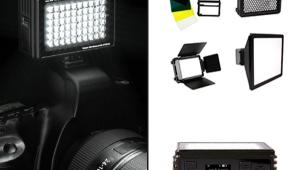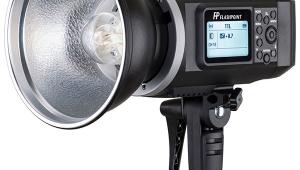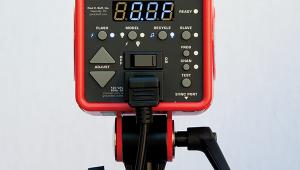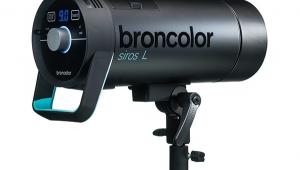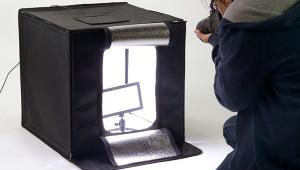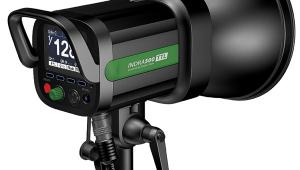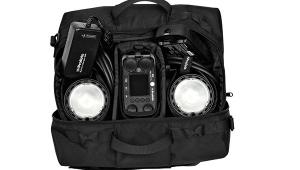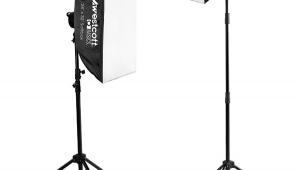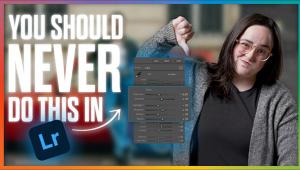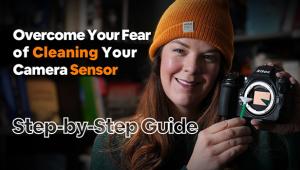Rotolight Anova LED EcoFlood: Is This The Future Of Studio Lighting?
In this test, Joe Farace tackles a higher-end LED light source that he adapted to still photography work. In it you will find technical sidebars outlining how we will test LEDs for the still photographer in the future. We offer this somewhat tech-heavy review as both a close look at this unit and a primer on LED output and LED lighting, which, as Joe states, will become increasing important, and prevalent, in studio and location work for the still shooter.—Editor
LED studio lighting is not only here to stay, I believe it’s the wave of the future. That’s one of the reasons I enjoyed working with Rotolight’s RL48-B portable lighting system. (Type the product name into the Search box on Shutterbug’s website for my review.) Part of the “big deal” about LED lighting is that it’s continuous, letting you see the shadows and highlights on your subject in real time and allowing in camera metering to measure the reflected light. Working in a no-flash environment means your subject tends to be more relaxed and, because there’s no waiting time for a light source to recycle, you should be able to make more and perhaps better portraits. Rotolight’s Anova LED EcoFlood builds on the technology found in the RL48-B and takes it in bigger and bolder directions.


What’s New
At full output, Rotolight’s Anova uses 38 watts of power, yet produces the equivalent light output of a 1000w tungsten bulb across 110 degrees. (See the “LED Output” sidebar on how we translate this to terms familiar to still photographers.)
The Anova uses 576 LEDs that together are capable of producing light in color temperatures ranging from 3150 to 6300 Kelvin. The Anova’s LEDs don’t use Pulse Width Modulation (PWM), which can cause rapid flickering that in some units gives the “appearance” of continuous light, but it’s not. When shooting in high fps mode, PWM can produce blank or black frames if a frame is captured at the moment when an LED flickers—much as when a subject blinks—but you may not notice it until viewing the images later. When used with other AC-powered lights, PWM LEDs may create a strobing effect when the AC current pulse and a competing PWM pulse from the LEDs go in and out of phase. The Anova won’t cause this kind of strobing, allowing it to be integrated into your existing studio lighting system.
When daisy-chained to its built-in DMX (Digital Multiplexing) port you can control lights from Arri or Lightpanels as well. This is fine for video, but still photographers can use the control dial on the Anova’s back that Rotolight calls the “encoder switch” to manually enter parameters, such as Brightness or Color Temperature that are shown on an LED display.
Magic Eye App
The unit’s built-in Wi-Fi has a 300-foot range and works with Rotolight’s Magic Eye iPhone/iPad app ($6.99) to sample ambient light and transmit color temperature to the Anova, allowing synchronization between location and studio. A ColorChecker-style calibration card is included in the aluminum ATA-stylecarrying case for calibrating the Magic Eye app. For all this apparent complexity, the Anova’s user guide is a mere 16 pages, including information on using Magic Eye.

All Photos © Joe Farace


Add-Ons
Options include barn doors, louvers, plus Fresnel, softbox, and T-connector plates. For location use, there’s an optional 98 mAh battery in a V-Lock mount that produces enough power at maximum output for a three-hour shoot. The Anova has more in common with cinema and TV lighting than typical photographic studio lighting gear, but that doesn’t mean you can’t use it in the studio, and that’s what I did.


At Work
An external transformer powers the Anova so it remains cool no matter how long it’s left on. The transformer is no bulkier than you might expect, but its 8-foot long power cord, the shortest of any studio light I’ve tested recently, could cause the cord to accidentally disconnect from the transformer unless securely attached to the light stand. The 8-foot cord was adequate for some studios but once on location it is extension cord city. Rotolight includes two nicely designed cable ties to solve this potential problem. Use them.
The Anova ships with a filter kit, similar to what’s bundled with Rotolight’s RL48-B, but it is somewhat less extensive, albeit physically larger. The six Lee filters include a full diffuser, medium diffuser, and cosmetic peach (diffusion plus skin tone enhancement) along with 1/8 minus green, 1/4 minus green, and 1/2 minus green to work in conjunction with fluorescent lighting. Since LEDs produce sharp, contrasty light, the medium diffuser might be a choice for some portrait subjects, and I made many images using it even though there’s a three-quarter stop loss because I felt it helped soften the quality of the light.
The diffusers and CC filters are held in place with what Rotolight calls “accessory mounting spigots” that look and function much like a muscle car’s hood pins and hold the elegantly designed gel frame holder in place.
Tip: There is a front and back to the filter holder. The flat side goes next to the Anova. Similarly, there are two holes in the pins for placing the spigots; with one filter use the inner hole to hold it securely. If you stack more than one filter, try the outer hole.
ISO Considerations
LED studio lighting systems are an excellent complement to today’s high-performance SLRs that have high ISO/low noise capabilities. When testing the Anova I used a Nikon D600 and shot an ISO bracket to see what ISO settings would work best, ultimately producing a test strip showing a bracket from ISO 400 through 500, 640, 800, 1000, 1250, and 1600. With the D600, the real world difference in noise between ISO 400 and 1600 is so small that I could only begin to see it at ISO 1600, and only at extremely large magnifications. Your camera will certainly be different. Shoot a bracket of ISO settings, evaluate them on a monitor, and make your decisions based on real data, not just Kentucky windage. That’s why, in shooting the examples you see here, I used settings from ISO 640 to 1250 with forays into ISO 1600 when the light was placed behind the subject.
White Balance
The Anova has a CRI of 93 (see “Color Rendering Index” sidebar) so I wanted to see how the output color matched an SLR’s white balance modes. I set up BD Company’s Silver Grey seamless paper background and asked the model to wear white, then set the Anova for 5500K while shooting a Nikon D600 in both Daylight and AWB color balance. Keep in mind that digital SLRs’ preset white balance settings vary between manufacturers. Some shooters may prefer to do a custom white balance or just shoot in Raw and correct in postproduction. It’s your choice.
One thing you can’t do is trust your old color temperature meter. Rotolight told me that traditional still photography color meters were not designed to measure color from LED lights. The Konica Minolta CL-200A chroma meter, used in the film and video industry, is specifically balanced for LED output and, according to my sources, “is the only meter that should be used for LED output.”
Rotolight’s optional ($229) barn doors are an ideal way to control the Anova’s 110-degree angle of coverage. The barn doors’ lightweight metal six-leaf design folds flat for easy storage and comes with mounting hardware and hex wrench just in case the doors loosen.
Tip: When installing the barn doors, don’t snug down all four bolts that hold it in place as you mount them. To make it easier to assemble, keep the bolts somewhat loose until after installing the last bolt; then tighten them all up.
Don’t be afraid to crank the barn doors all the way down because the LEDs remain cool under the most extreme barn door configuration. That’s why the Anova lacks a fan, making it an ideal companion for those shooters who, like me, prefer a quiet shooting environment. Mounting the barn doors somewhat limits the Anova’s ability to tilt downward, but by careful adjustment of the light stand height I was able to get the desired lighting effect. The barn doors were helpful whether I was trying to focus the light on a subject, allowing it to go more low key by keeping light off of a dark background, or when trying to replicate a vintage Hollywood lighting effect. Those masters used large continuous sources, making the Anova, with barn doors, handy for creating this kind of moody lighting, especially for portrait photographers offering boudoir sessions.
In my former home, I had one room with a north-facing bay window that provided wonderful light for portraits, but my current home is not as blessed. I’ve been trying to make portraits in an empty room but none of the lighting solutions I’ve tried could handle the contrast from light coming through the windows. Using the Anova with the Magic Eye app I was able to get my first acceptable results. Initially, the app takes some getting used to, but the learning curve is remarkably short and once learned you’ll discover how it’s not only intuitive but fun to control lighting from across the room or studio.
Tip: There are several apps with names similar to Magic Eye; use the App Store’s search function and type “Rotolight Anova” to find it fast.
LED Output
At full output, Rotolight’s Anova uses 38 watts of power, yet produces the same lighting output as a 1000w tungsten bulb. Its official output rating (in lux) is 2025 at 3.2 feet (1 meter), 506 at 8.2 feet (2.5 meters), and 156 at 13.12 feet (4 meters). Lux is a unit of illumination equal to one lumen per square meter or 0.0929 foot-candles. To interpret those numbers, Sekonic offers a chart (http://sekonic.com/Support/EVLuxFootCandleConversionChart.aspx) that compares the somewhat more familiar Exposure Value to foot-candles and lux.


An Exposure Value (EV) represents all of the combinations of shutter speed and aperture that will produce the same exposure. Using Sekonic’s chart to convert the Anova’s specifications into EV produces the following: output in EV is between 9.5 and 10 at 3.2 feet, between 7.5 and 8 at 8.2 feet, and 6 at 13.12 feet. Charts, such as Jim Beecher’s (http://photokaboom.com/photography/learn/tips/054b_exposure_light_and_exposure_values.htm), show the relationship of shutter speed to aperture at a given EV for a specific ISO setting. The EV for a full-length shot at approximately 10 feet at ISO 100 is EV 7 and using the chart converts the EV to 1/8 sec at f/4. Since that shutter speed is tricky to hand hold, even with a stabilized lens, and subject motion blur will also be a problem, ramping up the shutter speed to 1/125 sec would mean increasing the ISO from 100 to 800. Real life almost always introduces variables but this is surprisingly close to the exposure of my full-length shot of Misa Lynn, which was 1/100 sec at f/4.5 and ISO 800.
Guide Numbers (GN) measure flash output and while there can be no real GNs for continuous light sources because standard formulas ignore the effect of shutter speed on the amount of light striking the sensor, we could develop an Equivalent GN of the Anova’s output. As in my test of a previous continuous light source, I used the following formula based on the EXIF data retrieved from the full-length shot:
EGN = (Shooting Distance x Aperture) divided by the ISO factor.
Using an ISO factor of three compensates for the difference in ISO 100 and produces a theoretical Equivalent GN of 15 for Rotolight’s Anova. All of which proves that the Anova is a continuous light source, not an electronic flash, and while we’ve come to embrace electronic flash as the standard, this was not always the case. The first monolight, for example, was not produced until 1963, when Bowens introduced their monobloc.

Color Rendering Index
The Color Rendering Index (CRI) is a measure of a light source’s ability to accurately reproduce colors and uses a scale from zero to 100. CRI is measured by comparing the color rendering of a test source to that of a perfect source, which is generally a black body radiator. Both sources are used to illuminate standard samples. The perceived colors under reference and test illumination are compared using a standard formula and averaged over the number of samples (usually eight) to get the final CRI rating. At 80 a light reproduces 80 percent of the visible color spectrum the sun would produce at the same color temperature. A CRI of 100, taken at a color temperature of noon sunlight, will reproduce the colors found on a sunny day at noon. The Anova is rated at 93.
Conclusions and Recommendations
All of this wonderfulness is not without cost. The Anova is a professional tool and at $2598 is priced like one, too, but this is reflected in the unit’s high level of build quality. This is an amazingly rugged and versatile light source that can be used by itself or perhaps with a pair of the Rotolight RL48-B lights as accents to produce a totally LED-powered studio—a studio of the future. The Anova’s implementation of LED technology is clearly a game changer for the pro who shoots video and still images as well as the portrait and boudoir photographer who wants to work with cool, controllable, and continuous lighting in the studio or on location.
For more information and full specs, contact R.T.S. Inc. at www.rtsphoto.com.
- Log in or register to post comments


